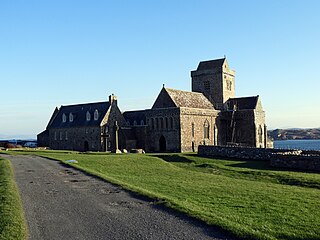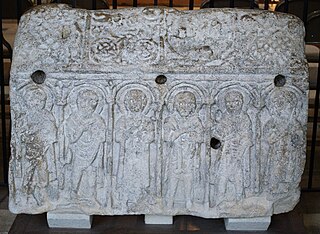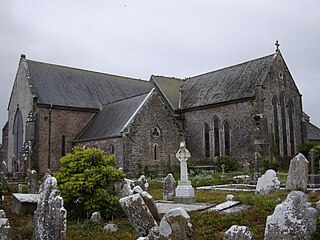The Culdees were members of ascetic Christian monastic and eremitical communities of Ireland, Scotland, Wales and England in the Middle Ages. Appearing first in Ireland and subsequently in Scotland, attached to cathedral or collegiate churches, they lived in monastic fashion though not taking monastic vows.

Bangor Abbey was established by Saint Comgall in 558 in Bangor, County Down, Northern Ireland and was famous for its learning and austere rule. It is not to be confused with the slightly older abbey in Wales on the site of Bangor Cathedral.

Iona Abbey is an abbey located on the island of Iona, just off the Isle of Mull on the West Coast of Scotland.

Lérins Abbey is a Cistercian monastery on the island of Saint-Honorat, one of the Lérins Islands, on the French Riviera, with an active monastic community.

Æthelwold of Winchester was Bishop of Winchester from 963 to 984 and one of the leaders of the tenth-century monastic reform movement in Anglo-Saxon England.
Christianity in Medieval Scotland includes all aspects of Christianity in the modern borders of Scotland in the Middle Ages. Christianity was probably introduced to what is now Lowland Scotland by Roman soldiers stationed in the north of the province of Britannia. After the collapse of Roman authority in the fifth century, Christianity is presumed to have survived among the British enclaves in the south of what is now Scotland, but retreated as the pagan Anglo-Saxons advanced. Scotland was largely converted by Irish missions associated with figures such as St Columba, from the fifth to the seventh centuries. These missions founded monastic institutions and collegiate churches that served large areas. Scholars have identified a distinctive form of Celtic Christianity, in which abbots were more significant than bishops, attitudes to clerical celibacy were more relaxed and there were significant differences in practice with Roman Christianity, particularly the form of tonsure and the method of calculating Easter, although most of these issues had been resolved by the mid-seventh century. After the reconversion of Scandinavian Scotland in the tenth century, Christianity under papal authority was the dominant religion of the kingdom.

Medeshamstede was the name of Peterborough in the Anglo-Saxon period. It was the site of a monastery founded around the middle of the 7th century, which was an important feature in the kingdom of Mercia from the outset. Little is known of its founder and first abbot, Sexwulf, though he was himself an important figure, and later became bishop of Mercia. Medeshamstede soon acquired a string of daughter churches, and was a centre for an Anglo-Saxon sculptural style.
Máel Ruba is an Irish saint of the Christian Church who was active in Scotland. Originally from Bangor, County Down, Ireland, he was a monk and founded the monastic community of Applecross in Ross, one of the best attested early Christian monasteries in what is now Scotland. Forms of his name include Máelrubai, Maol Rubha (MoRubha/MaRuibhe), or Malruibhe, and it is sometimes latinised as Rufus,

Inishmurray is an uninhabited island situated 7 km (4 mi) off the coast of County Sligo, Ireland.
Events from the 6th century in Ireland.

Nendrum Monastery was a Christian monastery on Mahee Island in Strangford Lough, County Down, Northern Ireland. Medieval records say it was founded in the 5th century, but this is uncertain. The monastery came to an end at some time between 974 and 1178, but its church served a parish until the site was abandoned in the 15th century. Some remains of the monastery can still be seen.

St. Colman's Cathedral, Cloyne is a cathedral of the Church of Ireland in Cloyne, County Cork in Ireland. It is in the ecclesiastical province of Dublin. Originally a Roman Catholic cathedral, it was converted to an Anglican cathedral in 1678.
Ardoileán or Ard Oileán, known in English as High Island, is a small island off the northwest coast of Connemara in County Galway, Ireland. It was once the site of an early Irish monastic community.

Ninnidh was a 6th-century Irish Christian saint. St. Ninnidh is regarded as one of the Twelve Apostles of Ireland. He is associated with shores of Lough Erne and particularly the island of Inishmacsaint and the parish of Knockninny, County Fermanagh, Northern Ireland. His feast day is 18 January.

Art in Medieval Scotland includes all forms of artistic production within the modern borders of Scotland, between the fifth century and the adoption of the Renaissance in the early sixteenth century. In the early Middle Ages, there were distinct material cultures evident in the different federations and kingdoms within what is now Scotland. Pictish art was the only uniquely Scottish Medieval style; it can be seen in the extensive survival of carved stones, particularly in the north and east of the country, which hold a variety of recurring images and patterns. It can also be seen in elaborate metal work that largely survives in buried hoards. Irish-Scots art from the kingdom of Dál Riata suggests that it was one of the places, as a crossroads between cultures, where the Insular style developed.

The English Benedictine Reform or Monastic Reform of the English church in the late tenth century was a religious and intellectual movement in the later Anglo-Saxon period. In the mid-tenth century almost all monasteries were staffed by secular clergy, who were often married. The reformers sought to replace them with celibate contemplative monks following the Rule of Saint Benedict. The movement was inspired by Continental monastic reforms, and the leading figures were Dunstan, Archbishop of Canterbury, Æthelwold, Bishop of Winchester, and Oswald, Archbishop of York.

Kill of the Grange, often Kill o' the Grange, is a suburban community and ancient parish in the half-barony of Rathdown, within the traditional County Dublin, in the jurisdiction of Dún Laoghaire-Rathdown. It contains an early religious site, which is a National Monument. The area, sometimees described as a twin of, and sometimes as part of, Deansgrange, is 5 miles southeast of Dublin.
The plague of 664 was an epidemic that affected Britain and Ireland in 664 AD, during the first plague pandemic. It was the first recorded epidemic in English history, and coincided with a solar eclipse. It was considered by later sources as "The Yellow Plague of 664" and said to have lasted for twenty or twenty-five years, causing widespread mortality, social disruption and abandonment of religious faith. The disease responsible was probably Plague – part of the First Plague Pandemic – or else smallpox.













